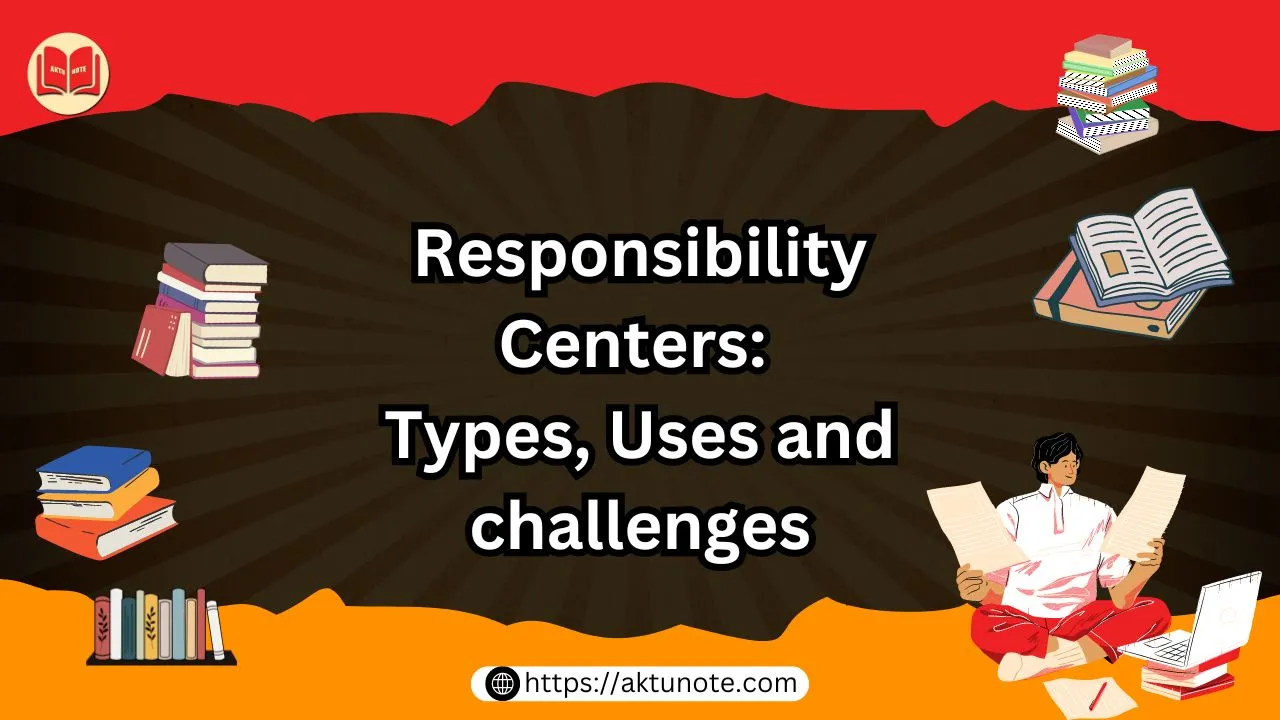Just like running a household, where everyone has their own chores and responsibilities to keep things running smoothly, businesses need to assign clear roles and duties to ensure efficiency and success. In the world of corporate management, these clearly defined roles are referred to as responsibility centers. Think of it like dividing up household tasks—someone’s in charge of cooking, another handles the finances, and someone else takes care of the yard. In a company, responsibility centers help leaders track performance and accountability within different departments or units, ensuring that each area is contributing to the organization’s overall goals.
A responsibility center is a specific part of a business, such as a department or division, where a manager or team is responsible for specific functions and is evaluated based on how well they manage resources, generate profits, or control costs. By setting up responsibility centers, businesses can measure performance more accurately and assign accountability to the right people—just like assigning chores to family members and making sure they’re doing their part.
In modern organizations, the effective delegation of authority and accountability is crucial for ensuring operational efficiency and strategic alignment. Responsibility centers are organizational units where managers are held accountable for specific financial and operational outcomes. These centers play a key role in the internal control systems of organizations by assigning responsibility for revenues, costs, profits, or investments to individual managers or teams. By creating responsibility centers, organizations can evaluate the performance of different segments, encourage accountability, and drive decision-making that supports overall strategic goals. This article explores the different types of responsibility centers, their roles in performance evaluation, and their significance in effective organizational management.
What Are Responsibility Centers?
A responsibility center is a department, unit, or function within an organization where a manager or leader is responsible for the performance of that area. The manager is accountable for planning, controlling, and monitoring activities to ensure that the unit meets its objectives. These centers allow businesses to track performance, allocate resources effectively, and hold managers accountable for their decisions and actions. It’s like when you give one family member the job of keeping track of the household budget—they’re responsible for making sure the bills get paid and money is being spent wisely.
Responsibility centers are typically classified into different types based on the nature of their responsibilities—whether they manage costs, revenues, profits, or investments.
A responsibility center is a distinct unit within an organization, such as a department, division, or business unit, where a manager is responsible for specific activities and is held accountable for the financial outcomes of those activities. The purpose of establishing responsibility centers is to decentralize decision-making and create a structure where managers have control over their areas of operation, while still being accountable to higher management for the results.
Responsibility centers allow organizations to:
- Delegate decision-making authority to managers who are closest to the operational activities.
- Measure the performance of individual units or departments.
- Align the performance of different units with the organization’s overall strategic objectives.
- Foster a culture of accountability by holding managers responsible for the results within their control.
Responsibility centers can be classified into several types based on the nature of the activities and the financial outcomes for which they are responsible. These include cost centers, revenue centers, profit centers, and investment centers.
Types of Responsibility Centers
There are four main types of responsibility centers that businesses use to track performance and accountability: Cost Centers, Revenue Centers, Profit Centers, and Investment Centers. Each type has its own focus and measures, just like different household responsibilities have their own set of tasks and expectations.
Cost Centers
A cost center is a part of the organization that is responsible for managing and controlling costs but does not generate revenue. The goal of a cost center is to operate efficiently while minimizing expenses. It’s like the person in the family who’s responsible for managing grocery shopping or keeping the house in good shape—they aren’t bringing in money, but they’re crucial for keeping costs under control.
Examples of Cost Centers:
- Human Resources Department: HR is responsible for managing personnel, benefits, and employee training—important functions that don’t directly generate revenue but are essential for the organization’s operations.
- IT Department: The IT team maintains the company’s technology infrastructure, ensuring everything runs smoothly without directly contributing to sales or profits.
- Facilities Management: This unit oversees the maintenance and operation of the physical space, such as offices and equipment, and aims to control operating costs.
In a cost center, managers are evaluated based on how well they control expenses and improve efficiency, not on how much revenue they generate.
Revenue Centers
A revenue center is focused on generating revenue for the organization, but it is not directly responsible for managing costs. The primary goal of a revenue center is to increase sales and bring in money. It’s like the family member who has a side hustle, selling homemade goods or providing services, and is responsible for bringing in extra income without worrying about household expenses.
Examples of Revenue Centers:
- Sales Department: The sales team is responsible for bringing in new customers and increasing revenue through product or service sales.
- Marketing Department: Marketing generates leads and builds brand awareness, driving customer interest and revenue without directly handling costs.
- Fundraising Department (in nonprofits): In a nonprofit organization, the fundraising team works to generate donations and funding to support the organization’s mission.
Revenue center managers are evaluated based on their ability to hit sales targets, grow the customer base, and increase overall revenue, without direct accountability for managing costs.
Profit Centers
A profit center is a unit within the organization that is responsible for both generating revenue and controlling costs, with the goal of maximizing profits. It’s like the family member who runs a small business—they’re bringing in money, but they’re also responsible for managing the business expenses and ensuring it’s profitable.
Examples of Profit Centers
- Product Line Divisions: A specific division that produces and sells a line of products, such as electronics or clothing, is responsible for both the revenue generated by sales and the costs associated with production, marketing, and distribution.
- Retail Stores: Each individual retail store within a chain may operate as its own profit center, responsible for sales as well as managing staff, rent, and inventory costs.
- Service Units: A consulting team within a larger organization might be a profit center, earning fees from clients while also managing the costs of delivering services.
Profit center managers are evaluated based on their ability to generate profits by balancing both revenue generation and cost control. This dual responsibility encourages efficiency and accountability across the unit.
Investment Centers
An investment center is a part of the organization that is responsible for generating profits while also making decisions about investments in assets, such as property, equipment, or new ventures. Managers in investment centers are evaluated not only on profits but also on how well they invest and manage the company’s resources. It’s like when a family decides to invest in property or start a new business—they need to make smart decisions that balance profitability with long-term investments.
Examples of Investment Centers
- Corporate Headquarters: At the highest level, corporate leadership may be responsible for overseeing investments in new businesses, expansions, or technology upgrades that affect the company’s long-term success.
- Strategic Business Units (SBUs): Large companies may have SBUs that operate as investment centers, responsible for making decisions about where to allocate resources for future growth.
- Real Estate Divisions: A company with a real estate division might be responsible for generating income through property rentals or sales while also managing investments in new developments.
Investment center managers are evaluated based on their return on investment (ROI), balancing profits with smart investment decisions to ensure long-term growth and sustainability.
Why Use Responsibility Centers?
Responsibility centers are crucial for organizations because they help divide accountability, improve decision-making, and align goals with overall business objectives. Here’s why they matter:
Accountability and Ownership
By creating responsibility centers, businesses assign clear accountability to managers, ensuring that each unit has a leader responsible for its performance. It’s like making sure everyone in the family knows their role—whether it’s doing the dishes, paying the bills, or handling yard work. This clear division of tasks keeps things organized and ensures that everyone is pulling their weight.
Performance Measurement
Responsibility centers allow businesses to measure the performance of different units more accurately. By assigning responsibility for costs, revenue, or profits to specific managers, companies can track how well each unit is doing and identify areas for improvement. It’s like checking in with each family member to see if they’re staying on top of their chores or responsibilities.
Strategic Focus
Responsibility centers help align different parts of the business with overall strategic goals. Each center has its own objectives—whether it’s reducing costs, increasing revenue, or improving profitability—that contribute to the company’s success. It’s like making sure that everyone in the family is working toward a common goal, whether that’s saving for a vacation or keeping the household running smoothly.
Improved Decision-Making
Because managers in responsibility centers have control over their areas, they’re better equipped to make informed decisions that benefit their specific unit and the company as a whole. It’s like giving each family member the authority to manage their own part of the household while keeping the big picture in mind.
Challenges of Responsibility Centers
While responsibility centers provide structure and accountability, they also come with challenges:
Coordination Between Centers
Sometimes, different responsibility centers may have competing priorities, leading to conflicts. For example, a cost center focused on reducing expenses may clash with a revenue center that wants to increase spending on marketing. Just like in a household, if one person is trying to save money while another wants to splurge, it can create tension.
Limited View of Overall Business
Managers in responsibility centers may focus too much on their specific goals without considering the broader impact on the company. For example, a profit center manager might focus on short-term profits at the expense of long-term investments. It’s like a family member cutting corners on quality to save money now but causing bigger problems down the road.
Misalignment of Goals
If responsibility centers are not aligned with the overall strategic goals of the company, managers might make decisions that benefit their unit but hurt the business as a whole. It’s like if one family member is focused on saving money for a new car while the rest of the family is saving for a vacation—misalignment can lead to inefficiencies.
For More Content Check Out :- KMBN 301
Conclusion
Responsibility centers are vital for improving accountability, streamlining decision-making, and aligning various parts of a business with its strategic goals. By dividing the organization into cost centers, revenue centers, profit centers, and investment centers, businesses can effectively track performance and assign accountability, ensuring that each unit contributes to the company’s overall success. Much like assigning clear roles in a household to keep everything on track, responsibility centers help businesses foster a culture of accountability, making sure everyone is working toward shared goals, making informed decisions, and driving long-term growth. Despite the challenges in managing these centers, their role in enhancing performance and supporting strategic objectives makes them indispensable for modern organizations.

